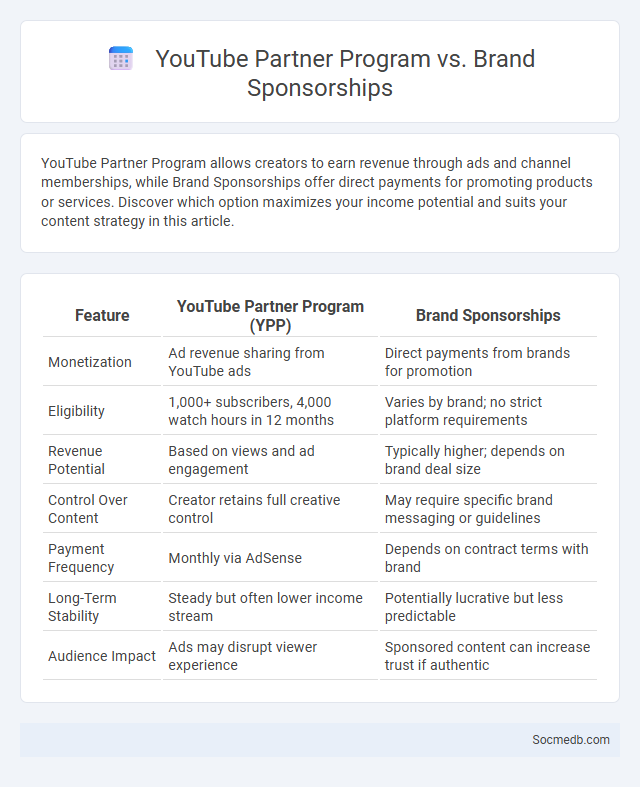
Photo illustration: YouTube Partner Program vs Brand Sponsorships
YouTube Partner Program allows creators to earn revenue through ads and channel memberships, while Brand Sponsorships offer direct payments for promoting products or services. Discover which option maximizes your income potential and suits your content strategy in this article.
Table of Comparison
| Feature | YouTube Partner Program (YPP) | Brand Sponsorships |
|---|---|---|
| Monetization | Ad revenue sharing from YouTube ads | Direct payments from brands for promotion |
| Eligibility | 1,000+ subscribers, 4,000 watch hours in 12 months | Varies by brand; no strict platform requirements |
| Revenue Potential | Based on views and ad engagement | Typically higher; depends on brand deal size |
| Control Over Content | Creator retains full creative control | May require specific brand messaging or guidelines |
| Payment Frequency | Monthly via AdSense | Depends on contract terms with brand |
| Long-Term Stability | Steady but often lower income stream | Potentially lucrative but less predictable |
| Audience Impact | Ads may disrupt viewer experience | Sponsored content can increase trust if authentic |
Understanding Monetization on YouTube
Understanding monetization on YouTube involves grasping its key components such as ad revenue, channel memberships, and super chats. You can earn income by enabling ads on your videos, attracting advertisers through engaging content, and growing your subscriber base. Maximizing your YouTube earnings requires optimizing video SEO, maintaining consistent uploads, and engaging your audience effectively.
What is the YouTube Partner Program?
The YouTube Partner Program (YPP) allows content creators to monetize their videos through ads, channel memberships, and Super Chat features. To qualify, your channel must have at least 1,000 subscribers and 4,000 watch hours in the past 12 months, meeting YouTube's community guidelines and monetization policies. Joining YPP unlocks access to YouTube's revenue-sharing opportunities and advanced creator tools for growing your audience.
How Brand Sponsorships Work on YouTube
Brand sponsorships on YouTube involve companies partnering with content creators to promote products or services through integrated video content. Sponsored videos typically feature product placements, direct endorsements, or branded challenges that align with the creator's audience and style, maximizing engagement and brand visibility. Payment models vary from flat fees and affiliate commissions to performance-based rewards depending on views, clicks, or conversions driven by the sponsored content.
Key Features of the Partner Program
The Partner Program offers exclusive tools for social media influencers to enhance content monetization and audience engagement. Your access to in-depth analytics and direct brand collaboration opportunities streamlines growth and maximizes revenue potential. Customized support and priority content promotion ensure you stay competitive in the evolving digital landscape.
Revenue Streams: Partner Program vs Brand Sponsorships
Social media platforms generate revenue primarily through Partner Programs and Brand Sponsorships, each offering distinct benefits for content creators. Partner Programs provide consistent income through ad revenue sharing, leveraging YouTube's monetization features and Facebook's in-stream ads. Brand Sponsorships deliver higher earnings by connecting creators with companies seeking targeted promotions, enhancing Your ability to capitalize on niche audiences and influencer marketing strategies.
Eligibility Requirements for Monetization
Eligibility requirements for social media monetization typically include meeting a minimum follower count, such as 1,000 subscribers on YouTube or 10,000 followers on Instagram. Platforms often require creators to maintain a specific amount of watch time or content engagement, like 4,000 watch hours over the past 12 months on YouTube. Compliance with community guidelines and adherence to platform-specific policies are crucial to ensure continued access to monetization features.
Pros and Cons of the YouTube Partner Program
The YouTube Partner Program offers creators an opportunity to monetize their content through ads, channel memberships, and super chats, enhancing your revenue streams and audience engagement. However, it requires meeting strict eligibility criteria, including 1,000 subscribers and 4,000 watch hours in the past year, which can be a barrier for new creators. You must also navigate YouTube's content policies carefully, as violations can lead to demonetization or channel suspension.
Pros and Cons of Brand Sponsorships
Brand sponsorships on social media amplify your reach by leveraging influencers' established audiences, increasing brand visibility and credibility. However, aligning with the wrong influencer can damage your brand reputation due to mismatched values or controversies. Careful selection and monitoring are essential to maximize the benefits and minimize the risks associated with social media sponsorships.
Which Monetization Strategy Is Right for You?
Choosing the right social media monetization strategy depends on your audience size, content type, and engagement level. Sponsored content suits influencers with a loyal following, while affiliate marketing benefits creators who recommend products related to their niche. Platforms like YouTube and Instagram enable ad revenue sharing, best for high-traffic channels with consistent video or photo content.
Maximizing Earnings: Combining Both Approaches
Maximizing earnings on social media requires strategically combining organic content and paid advertising to leverage the strengths of both methods. By nurturing authentic engagement through organic posts and boosting visibility with targeted ads, you can optimize reach and conversion rates. Your ability to analyze platform algorithms and audience insights directly impacts the effectiveness of this integrated approach and increases revenue potential.
 socmedb.com
socmedb.com